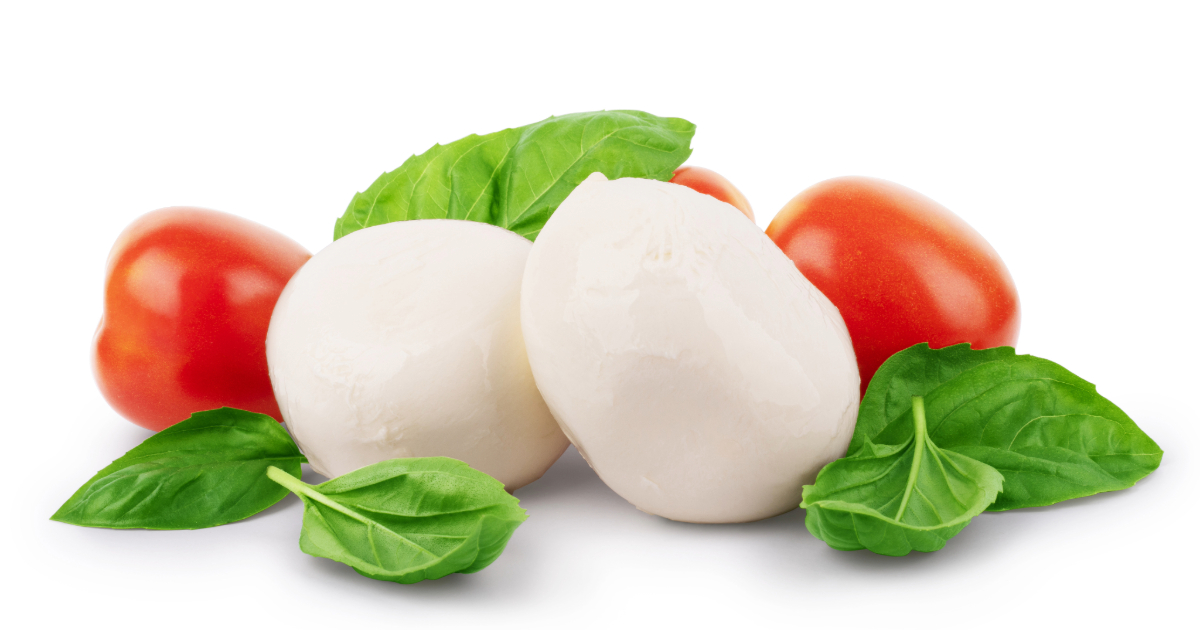Brick and mozzarella are two popular pizza cheeses, but they have key differences.

We explore everything you need to know about brick cheese and mozzarella to determine which is best for your needs.
What is Brick Cheese?
Brick cheese is a semi-hard cow's milk cheese that originated in Wisconsin in 1877. Brick cheese gets its name from the process of pressing the cheese under bricks during production.
This cheese has an ivory color and a tangy, sweet flavor with nutty notes. When young, brick cheese is mild in flavor. However, when aged for longer periods, it develops a stronger, more pungent taste and aroma.
The high fat content of brick cheese gives it excellent melting properties. Its texture is smooth and Sliceable with small holes or openings throughout.
Brick cheese works well in cooked dishes like pizza, pasta, paninis, and mac and cheese due to its meltability. The aged variety can be quite strong on its own but pairs nicely with crackers, fruit, and wine or beer.
What is Mozzarella Cheese?
Mozzarella is a soft, white cheese originally from Italy made using the pasta filata method. In this method, the curd is stretched and kneaded in hot water, then formed into balls or braids.
The term "mozzarella" also refers to the cheese produced specifically from the milk of Italian Mediterranean buffalo. However, most mozzarella today comes from cow's milk.
True mozzarella cheese has a high moisture content, making it extremely soft with an elastic texture. It melts easily when cooked and heated. Flavor-wise, fresh mozzarella has a milky, delicate taste and aroma.
Low-moisture mozzarella used for cooking has a firmer texture and tangier flavor. Ovolini mozzarella are small egg-sized balls packed in whey or brine. Smoked mozzarella (scamorza) offers a unique twist on this classic cheese.
Brick Cheese vs. Mozzarella
Now that you know the basics, here is a detailed comparison of brick cheese and mozzarella:
Flavor
- Brick cheese is tangy, sweet, and nutty in flavor. When aged, it has a stronger taste and smell.
- Mozzarella is milky and delicate in flavor. Low-moisture mozzarella can be mildly tangy.
The flavor difference comes down to tangy, nutty brick cheese versus the subtle, milky notes of fresh mozzarella.
Texture
- Brick cheese has a dense, sliceable texture with small holes throughout.
- Mozzarella is soft and elastic, especially when fresh. Low-moisture mozzarella is firmer.
Brick cheese is semi-hard, while traditional mozzarella is soft and stretchy.
Fat Content
- Brick cheese has a high fat content, around 27-30% or more.
- Mozzarella also has a high fat content but slightly less than brick, around 22-26% typically.
Both cheeses are high in fat, but brick cheese edges out mozzarella. The extra fat gives brick excellent meltability.
Melting Properties
- Brick cheese melts smoothly due to its high fat content.
- Fresh mozzarella melts into thick strands and strings. Low-moisture melts evenly.
Brick cheese makes an ideal melting cheese thanks to its fat content and smooth melting texture.
Origins
- Brick cheese originated in Wisconsin in the USA in 1877.
- Mozzarella traces its roots to southern Italy. Originally made from water buffalo milk.
Brick cheese is truly an original Wisconsin, American cheese. While mozzarella hails from Italy.
Best Uses
- Brick cheese works well in cooked dishes, sandwiches, pizza and casseroles.
- Mozzarella excels as a topping for pizza, in salads like caprese, stuffed into breads and as a snack cheese.
Brick cheese holds up beautifully to heat and melting, making it a cook's cheese. Mozzarella offers a fresh finishing touch uncooked.
| Brick Cheese | Mozzarella | |
|---|---|---|
| Origin | Wisconsin, USA | Italy |
| Texture | Dense, sliceable | Soft, elastic |
| Flavor | Tangy, nutty | Mild, milky |
| Fat Content | High (27-30%+) | High (22-26%) |
| Melting | Smooth melter | Variable melt |
| Best Uses | Hot dishes, pizza | Toppings, salads, snacking |
Key Takeaway: Brick cheese has tangy flavor and smooth melting properties thanks to its high fat content. Mozzarella offers a subtle, milky taste and soft, stretchy texture perfect for snacking and toppings.
Brick Cheese on Pizza
One area where brick cheese shines is Detroit-style pizza. Detroit-style pizza features a thick, airy crust which gets topped edge-to-edge with brick cheese before adding sauce and other toppings.
As the pizza bakes in a well-oiled pan, the brick cheese melts beautifully into the crust and caramelizes around the edges to form that distinctly crispy Detroit pizza crust.
The high fat content and meltability of brick cheese make it ideally suited for achieving the signature crispy crust and soft, cheesy interior mouthfeel of a Detroit pie.
Using a blend of brick and mozzarella cheese will also provide great results, combining the melt of brick cheese with the mild flavor and stretch of fresh mozzarella. Just be sure to maximize the amount of brick cheese touching the crust.
For best results making Detroit-style pizza at home, choose high-quality Wisconsin brick cheese and use a heavy steel pizza pan like those used in the Motor City. Bake your home pizza at a high temperature to promote browning and crisping.
Mozzarella Cheese on Pizza
Mozzarella may be the most popular global pizza cheese, but it does have some downsides.
High-moisture fresh mozzarella can lead your pizza crust to become unpleasantly soggy in the middle. The uncooked cheese also lacks flavor development without some nice browning.
Low-moisture mozzarella offers better melt and less oozing moisture compared to fresh. But it still can't achieve the crispy, fried edges of brick cheese Detroit pizza.
That said, you can't go wrong topping pizza with high-quality fresh mozzarella cheese. Just don't overdo it, and make sure to drain any excess liquid for the best results.
And for snacking, fresh mozzarella is infinitely better than brick cheese thanks to its clean dairy flavor and pillowy texture when eaten raw.
Buying Brick Cheese vs. Mozzarella
When shopping for brick or mozzarella cheese, you'll discover quite a difference in availability, price and quality depending on where you live.
As a specialty Wisconsin original, brick cheese can be difficult to source outside of the Midwest and parts of the Northeastern United States. Even then, finding authentic aged brick cheese takes some effort compared to the mild young version.
Mozzarella on the other hand is produced everywhere and is one of the most widely available cheeses globally thanks to pizza popularity. But not all mozzarella is created equal.
To ensure you get authentic, high-quality cheeses:
- Brick cheese - Seek out Wisconsin-made brick cheese for authenticity, Widmer's brand is excellent
- Mozzarella - Check labels for "mozzarella di bufala" to get the real-deal imported Italian water buffalo variety. Otherwise, choose domestic brands like Galbani or BelGioioso for cow's milk mozzarella made in Wisconsin.
Getting the good stuff does come at a price - expect to pay around $6 per pound for basic mozzarella cheese and upwards of $8-12 per pound for gourmet fresh mozzarella or aged brick cheese.
Key Takeaway: Brick cheese can be hard to find outside the Midwest, while basic mozzarella is ubiquitous. Seek out authentic cheesemakers for premium quality either way.
FAQs
What's the difference between brick cheese and cheddar?
Cheddar cheese is an English cheese made by a cheddaring process to knit the curds. Brick cheese uses a washing process more like Limburger cheese. Both can be aged but brick cheese is softer, higher moisture, and has a tangier flavor.
Can you substitute mozzarella for brick cheese?
Yes, you can substitute mozzarella for brick cheese in cooked dishes like pizza with decent results. But you won't achieve the same crispy crust and caramelization during baking. For best results, use a brick and mozzarella blend.
Is brick cheese better than mozzarella?
It depends on the application. Brick cheese melts and crisps up better making it excellent for Detroit-style pizza and other baked dishes. Mozzarella offers a creamy, delicate flavor perfect for topping pizzas, homemade breads, salads and snacking.
What tasting notes does brick cheese have?
Young brick cheese has a mildly tangy and sweet flavor with nutty notes. Aged brick cheese becomes more assertive with a potent aroma and sharper taste.
What cheese does Little Caesars use?
Little Caesars uses a proprietary blend of mozzarella and Muenster cheese they call “Muenster Blend” for their signature pizzas.
Conclusion
While mozzarella may reign supreme as the world's favorite pizza topper, brick cheese deserves your attention for baking up the crispiest, cheesiest pizza crust possible.
This lesser-known Wisconsin original delivers big on flavor and melt with excellent fat content to fry up those irresistible edges. Look for it next time you make Detroit or Sicilian-style pizza.
And let's not dismiss the subtle milky tastes of fresh mozzarella. When it comes to topping pizza hot out of the oven or making insalata Caprese, few cheeses compare to fresh imported mozzarella di bufala.

